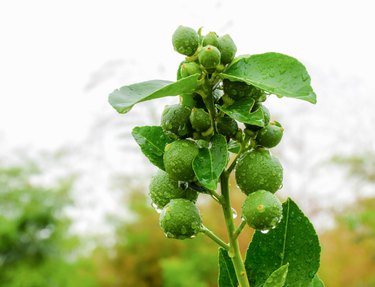
In the late 1700s, the British Royal Navy served limes aboard its sailing ships to fight off scurvy. Today limes are used to add some zip to margaritas or to flavor a classic key lime pie. The different types of lime trees found in the United States include key lime trees, Tahitian lime trees and Thai lime trees. They produce slightly different fruits, but all do best in hot climates.
Key Lime or Mexican Lime
Video of the Day
The key lime, or Mexican lime (Citrus aurantifolia), is a small tree that tops out at about 20 feet tall. It thrives in U.S. Department of Agriculture plant hardiness zones 9 to 11, and can live for 150 years. The tree is an evergreen, with glossy, medium green leaves, either elliptical or oblong in shape. The crown is dense, making the key lime an excellent shade tree. The bark is smooth and dark brown in color. Some trees have thorns.
Video of the Day
White, fragrant flowers bloom in spring, averaging 2 inches in width, and can be solitary or in small groups. When they first emerge, the petals have a slightly purple tinge that fades quickly. Flowers have both male and female parts, known as perfect flowers.
Each trees produces many limes. They are round, yellow to green, and usually measure 2 to 3 inches in diameter. The limes start out with a green peel, but as the fruit ripens it turns pale yellow and can be rough or smooth. The flesh is greenish-yellow, fragrant, juicy, flavorful and filled with varying amounts of seeds. Key lime normally fruits in winter, but is also known to produce fruit during the spring and summer.
Tahitian Lime or Persian Lime
The Tahitian lime (Citrus latifolia), also called the Persian lime, thrives in USDA zones 9 to 11. It is believed to be a hybrid of the Mexican lime and either citron or lemon. Trees grow up to 20 feet tall, with widespread branches and fewer thorns than the Mexican variety.
The leaves are a medium green and shaped like the head of a lance. They have winged petioles, or pronounced stems. Young shoots have a purplish tinge that soon fades. Flowers can bloom year-round but are most prolific in January. They are white with a slight purple tinge. The limes produced by these trees are usually seedless. Each is between 2 and 3 inches long and up to 2.5 inches wide, with a greenish-yellow rind when ripe.
Thai Lime or Kaffir Lime
A native of Southeast Asia, the Thai, or kaffir, lime tree (Citrus hystrix) requires slightly warmer temperatures than other types of lime trees. It thrives in USDA zones 10 to 12. While it often grows as a shrub, it can also grow to 25 feet tall. The species name, hystrix, comes from the Greek word for hedgehog. It was bestowed on this lime because of the many thorns on the branches.
The Thai lime tree is mostly grown outdoors in California and Florida. In cooler climates, Thai lime can be potted and grown indoors. Indoor plants require lots of sunlight and frequent watering and misting. Ideally, the plants can be set outside during the warmer seasons and brought back indoors when the average temperature falls below 60 degrees Fahrenheit. This tree is an evergreen. Its glossy, double leaves are aromatic when crushed. The leaves are often used in Asian dishes and marinades. Thai lime flowers throughout the year, with white-petaled blooms found in small clusters of four or five. The fruit is roundish, green, with a bumpy rind and can grow up to 2 inches in diameter. The pulp flavor is acidic, but there is little juice. The pulp, as well as the sour-tasting bumpy rind, are often diced or grated and used in cooking.